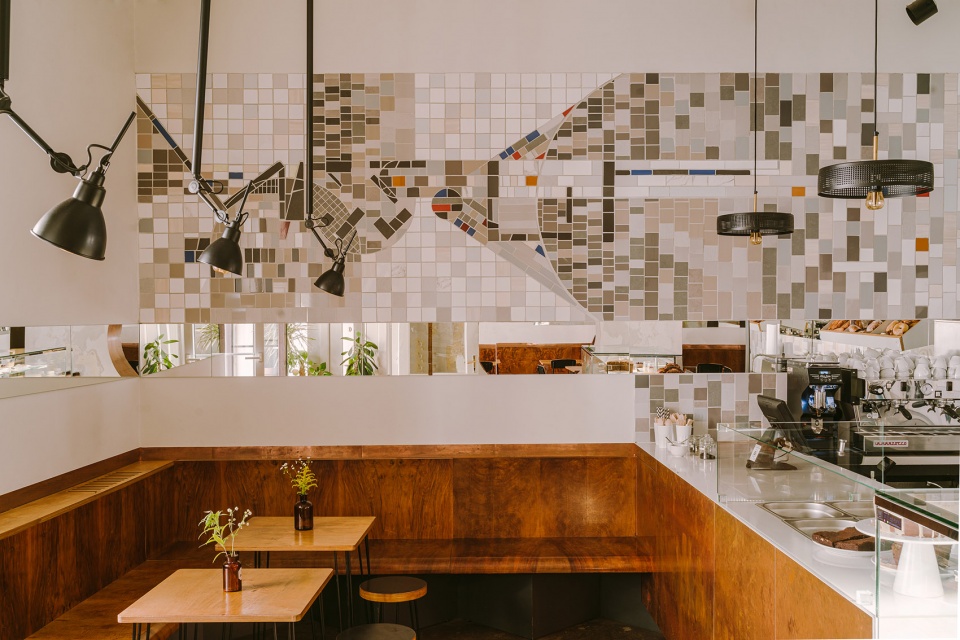波兰克拉科夫MASSOLIT咖啡厅,一个孔框出两幅画

咖啡厅位于波兰克拉科夫的犹太人区,其内供应纽约风味的原味芝士蛋糕和传统的hamantaschen饼干。咖啡厅展现出多元文化氛围及克拉科夫本土特色。来自miastopracownia事务所的波兰建筑师Barbara Nawrocka和Dominika Wilczynska携手改造了这间历史悠久的建筑,既保留了其具有年代感的建筑元素和细节,又创造出充满活力的现代化聚会空间。
There is a cafe in the middle of Jewish district in Cracow (Poland) that serves original New York-style cheesecake and traditional hamantaschen cookies. It combines multicultural influences and local atmosphere. The historical neighbourhood was an inspiration for Polish architects, Barbara Nawrocka and Dominika Wilczynska from miastopracowniaoffice to create a vivid, modern meeting place with architectural elements and details derived from the past.
▼咖啡厅前台,供应多种甜点,front desk, offering a variety of dessert © PION STUDIO

咖啡厅室内最显著的特征是一堵开有圆孔的墙壁。该墙壁分隔了两个空间,却又留有视线上的关联。透过墙上的开孔,可以欣赏到两侧房间内现代主义装饰。一侧房间墙壁上布置有陶瓷马赛克,其图案由建筑师为咖啡厅设计。马赛克取材于废弃瓷砖,并采用手工拼贴。另一侧房间墙面上悬挂着金属架和盆栽。金属架的网格与墙面瓷砖的拼贴线形成某种程度上的呼应。
▼陶瓷马赛克,ceramic mosaic © PION STUDIO


▼从墙上圆孔中看到另一侧的马赛克,view of the mosaic though the round hole on the wall © PION STUDIO

The most characteristic element of the interior is a round hole in the wall. It connects two rooms and creates a view frame for each part of the place. Looking through it, we can observe a ceramic mosaic on one side and a decorative metalwork that is a wall plants hanger on the other. Each one is a contemporary reference to modernism. Architects designed the mosaic pattern and decided to use waste ceramic tiles to be arranged manually. The layout of the divisions of the metalwork and the tiles joints create some kind of a mirror image of each other.
▼从圆孔中看到另一侧墙壁上的金属架及盆栽,view of the metal frame and plants on the wall from the round hole © PION STUDIO


旧家具的再利用也体现了设计中对传统的尊重。咖啡厅内使用的椅子是从网上拍卖会购得的老式课桌椅,仅将其改涂成黑色。沿墙壁放置的长椅所用的木材,来自于一个1950年代的旧胶合板橱柜。只剩长椅靠背上闪闪发光的黄铜钥匙孔,暗示着我们材料的原貌。
A reference to tradition is also manifested by the reuse of old, abandoned furniture. Chairs in the café are old school furniture bought at an online auction and painted black. The benches along the walls were made of wood from old veneer cabinets from the 1950s. Only brass keyholes glisten in the backrests can remind us of the previous function of the material.
▼咖啡厅内使用了翻新的旧家具,reuse of old furnitures © PION STUDIO

▼老式课桌椅及使用旧木材制作的长椅,old school desks and chairs and benches made of old wood © PION STUDIO


▼长椅的椅背上留有黄铜钥匙孔,brass keyholes glisten in the backrests © PION STUDIO

柜台正面及墙壁圆孔的细节处表面覆盖有铜。铜的颜色会随着时间的流逝而改变,从而与深浅不同的旧木材更好地匹配。咖啡厅地板采用了未加工的混凝土,表面覆盖有透明树脂,很好地呈现出材质原有的质感。室内墙壁裸露出带有岁月痕迹的石膏层,以此来展现建筑物的历史风貌。
Particular details and surfaces like the front of the counter and the round hole in the wall are covered with copper. The material changes its colour so with a time it will match even better with various shades of old wood. Architects exposed layers of the floor, displayed raw concrete and covered it with transparent resin. Miastopracowniarefined and planned every detail. They tried to reveal the history of the building by exposing layers of plaster but let the history pick the wall colour.
▼墙壁裸露处带有岁月痕迹的石膏层,exposing layers of plaster and let the history pick the wall color © PION STUDIO


了解更多餐饮空间设计与餐饮行业资讯
关注孟萨空间设计:www.mengsa.com.cn
开源节流,从设计开始

